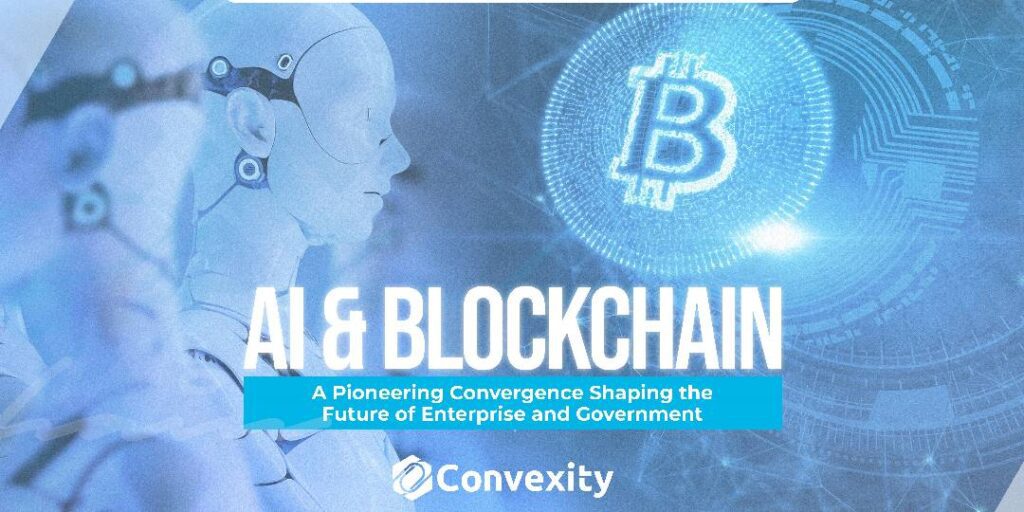
Introduction
In the present age of advancing technological landscape, at Convexity we identified Artificial intelligence (AI) and Blockchain technology as two of the most transformative technologies with the potential to reshape enterprise and government processes and function.
We would be exploring the similarities, differences, and the remarkable convergence of AI and Blockchain technology, illustrating how this symbiotic alliance will shape the future of enterprise and government sectors.
Definition
Understanding these two technologies is the first step in efficient usage and adoption:
Artificial Intelligence(AI) is the ability of machines to learn, analyze, and mimic human intelligence to make independent decisions,
while Blockchain is a distributed ledger technology that stores data in blocks that are linked together in a chain and allow for secure, transparent, and tamper-proof transactions without the need for intermediaries in a decentralized network.
Similarities
Despite their different origins, AI and blockchain technology share several similarities:
- Both technologies are based on the principle of distributed computing, which means that they rely on a network of computers to function. This makes them both highly secure and resistant to attack. This distributed computing or decentralization enhances security, making it harder for malicious actors to compromise data or manipulate AI models. This attribute can significantly bolster data privacy and security in enterprise and government systems.
- Additionally, Both AI and Blockchain technology rely heavily on data. AI algorithms require vast amounts of high-quality data to train models and make accurate predictions. Similarly, Blockchain records and validates data in a tamper-resistant manner, ensuring the integrity and reliability of the information it holds. By integrating AI with Blockchain, enterprises, and governments can ensure the use of trustworthy data to drive intelligent decision-making.
Differences
While AI and blockchain technology share some similarities, there are also some key differences between the two technologies.
- AI is a general-purpose technology with an objective to replicate human-like intelligence and enhance automation, to proficiently process data and make informed decisions for a wide variety of tasks,
while blockchain is a more specialized technology created for trust in transactions and eliminating intermediaries, ensuring a secure and tamper-proof ledger. - Additionally, AI is typically centralized, while blockchain is decentralized.
Convergence and Use-Case for Enterprise and Government
Although they have distinct functions, there is increased interest in how to converge and maximize AI and blockchain technology, the two technologies complement each other tremendously:
a. Enhanced Data Security and Privacy: By combining AI and Blockchain, enterprises and governments can ensure the secure storage and sharing of sensitive information. AI-driven encryption and access control mechanisms, supported by Blockchain’s tamper-resistant nature, would protect data against unauthorized access and manipulation.
b. Transparent Governance and Fraud Prevention: Governments can leverage AI and Blockchain to improve transparency in public services. Blockchain can be used to maintain an immutable record of government transactions and credentials, while AI algorithms can analyze patterns and detect anomalies, reducing corruption and ensuring better governance.
c. Humanitarian aid distribution: AI-powered predictive analytics combined with blockchain’s transparent and immutable ledger can optimize aid distribution by identifying areas with the greatest need, tracking donations, and ensuring efficient allocation of resources. An example of such is chats.cash solution used across Sub-Saharan Africa.
d. Streamlined Supply Chains: The fusion of AI’s predictive capabilities with Blockchain’s transparent ledger can optimize supply chain management. AI can analyze real-time data, predict demand, and identify bottlenecks, while Blockchain can ensure traceability and authenticity throughout the supply chain, reducing inefficiencies and fraud.
e. Decentralized Identity and Authentication: AI-powered biometric authentication combined with Blockchain-based identity management can offer secure and decentralized identity verification. This convergence can mitigate identity theft, ensuring privacy while providing efficient and reliable authentication services.
f. Enhanced Cybersecurity: Combining AI’s predictive capabilities with Blockchain’s tamper-resistant ledger can revolutionize cybersecurity measures. AI-driven security systems can analyze network traffic and detect anomalies, while Blockchain ensures the authenticity and immutability of security logs and event records. This synergy fortifies defenses against cyber threats and makes enterprise and government systems more resilient.
g. Decentralized Governance and Voting: Blockchain-based voting systems, powered by AI algorithms, can revolutionize democratic processes. These systems can offer secure and verifiable voting, ensuring the integrity of the electoral process and increasing voter participation. The decentralized nature of Blockchain technology makes it resistant to external interference, safeguarding the sovereignty of democratic decisions.
Conclusion
At Convexity, we understand the immense potential and leverage AI and Blockchain technology offers to Enterprise products and even Government agencies that adopt it. In an age of distrust and inefficiency, these two technologies offer solutions and economic benefits unimaginable globally.
Let us collaborate to shape a world where innovation isn’t limitless, and progress has no boundary, with transparency and efficiency redefining the norm.
Consult with us today, and let Convexity Technologies guide you into a new era of limitless possibilities. The future awaits – take the first step towards innovation now.
Email: info@convexity.com
Quick link: https://withconvexity.start.page/



